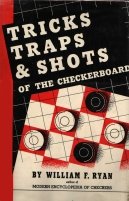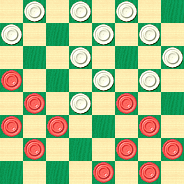The Checker Maven
Jump to navigationSturges Steamroller

You wouldn't want to get in the way of the powerful looking machine shown above; it's something not to be tangled with. But today's entry from Willie Ryan's Tricks Traps & Shots of the Checkerboard is both powerful and tangled. It's a complex situation with quite a fine solution. Willie has a lot to say about it; take the time to play through the notes and variations to enhance your understanding and enjoyment of this one. With the help of modern computer analysis, we've added even more notes of our own.

| 11-15 | 16-20 | 8-11 |
| 23-18 | 24-19 | 29-25---C |
| 8-11 | 7-16 | 10-14---2 |
| 27-23 | 22-18 | 19-15---3 |
| 11-16---A | 4-8 | 3-8 |
| 18-11 | 25-22---B | 22-17---U. |

BLACK
Black to Play and Win
B:W32,31,30,28,26,25,23,21,18,17,15:B20,16,14,12,11,9,8,6,5,2,1.
"At this point, white has fallen into a hoary snare, first shown by Joshua Sturges in 1800, which has been victimizing the innocents since its inception. The diagram shows the position after white's fateful faux pas."
A---With this move, black inaugurates the Slip Cross opening, one-time favorite of go-as-you-please players. Although white seems to have the upper hand on most variations of play, black's winning chances are by no means meager.
B---The only fertile move at this stage. If white takes 31-27, black can force a draw as follows: 31-27, 9-14, 18-9, 5-14, 25-22, 8-11, 28-24, 3-7, 22-18, 1-5, 18-9, 5-14, 26-22, 11-15, 22-17, 7-11*, 29-25, 6-9*, 17-13, 14-18*, 13-6, 2-9, 23-5, 16-23, 27-18, 20-27, 32-23, 15-29. J. Tonar.
C---In recent years, the prescribed move has been worn thin by wide and constant usage, and it is now being replaced by the lesser known 22-17---1, as follows:
| 22-17 | 5-14 | 18-9 | 2-7---F | 23-16 |
| 10-14---D | 29-25---E | 5-14 | 22-18 | 12-19 |
| 17-10 | 3-7 | 26-22 | 14-17 | 18-14 |
| 6-24 | 25-22 | 11-15 | 21-14 | 19-23---G, |
| 28-19 | 7-10 | 32-28 | 10-17 | ending in a |
| 9-14 | 22-18 | 15-24 | 19-15 | draw. |
| 18-9 | 1-5 | 28-19 | 16-19 | Frank Dunne. |
D---The great Frank Dunne, "King Kong" of yesteryear's draughts scribes, was the first to show play on this reduction, which at once throttles all threats by white. The move most frequently taken here is 9-14, although it is not so good as Dunne's 10-14 trouble eliminator. All the major points of the 9-14 line are outlined in the following play:
| 9-14 | 17-14 | 10-15 | 21-17 | 23-30 |
| 18-9 | 10-17 | 18-14 | 16-19 | 32-7; |
| 6-22---H | 21-5 | 15-18*---M | 10-7 | drawn. |
| 26-17 | 3-7 | 14-10 | 2-11 | Wm. F. |
| 5-9---K | 29-25 | 11-15* | 27-24 | Ryan. |
| 23-18---L | 7-10 | 31-27 | 20-27 | |
| 16-23 | 25-21 | 12-16* | 30-26 | |
E---White does not have any alternative play here worthy of mention. If he tries 26-22, then the countering play will be: 3-7, 29-25, 7-10, 22-18, 1-5, 18-9, 5-14, 25-22, and we are back to Note C, on the seventeenth move.
F---Another way to draw here is by: 20-24, 22-18, 24-28, 18-9, 28-32, 21-17, 32-28, 31-27, 2-7, 9-6, 7-11, 6-2, 11-15, 27-24, 16-20. Wm. F. Ryan.
G---Black has virtually forced the draw all the way from Note D (10-14). This is big league analysis.
H---Black is not really pinched here. The center jump also produces the draw; viz: 5-14, 29-25, 3-7*---I, 25-22, 11-15, 17-13, 15-24, 28-19, 14-17*, 21-14, 10-17, 22-18, 20-24, 18-15, 16-20, 19-16, 12-19, 23-16, 24-27, 32-23, 6-9, 13-6, 1-19. P. H. Ketchum vs. J. H. Scott.
I---A vital point in the defense. If 11-15 is tried, a draw by black is doubtful against the following play: 25-22, 15-24, 28-19, 20-24---J, 19-15, 10-19, 17-10, 6-15, 23-18, 24-27, 32-23.
J---A player by the name of J. S. Heyes attempted to show a draw here by 3-8, 17-13, 8-11, 22-18, 1-5, 18-9, 5-14, 26-22, 20-24, 22-18, 6-9, 13-6, 2-9, 31-26, 24-28, 26-22, 9-13, 18-9, 11-15, 9-6, 15-24; at this point Heyes recommended 23-18, which allows black to draw neatly by 24-27 etc.; but if instead of 23-18, you play 6-2, the win becomes obvious.
K---Several authors have claimed that this move is a losing one; but it may be played to a draw without exertion. At K, black can also draw by 3-7, 17-14 (if 29-25, 5-9, 23-18 are moved, Note D will apply), 10-17, 21-14, 1-6, 29-25, 6-9, 31-27, 9-18, 23-14, 16-23, 27-18, 11-16, 25-22, 20-24, 28-19, 16-23, 14-9, 5-14, 18-9, 7-11, 22-17, 11-15, 17-13, 15-19, 9-6, 2-9, 13-6, 12-16. A. E. Greenwood.
L---If 29-25 is played, then the draw comes about with: 9-14, 17-13, 3-7, 13-9, 11-15, 25-22, 15-24, 28-19, 7-11, 22-18, 20-24, 9-5, 16-20, 18-9, 24-27, 31-24, 20-27, 23-18, 27-31, 21-17, 11-16, 18-15, 16-23, 15-6, 1-10, 5-1, 10-15. Wm. F. Ryan.
M---The only move to draw. 11-16 loses and sets up a fine problem study by Champion John T. Bradford, American member of the 1927 International Checker Team. We illustrate the position (after 11-16) with a diagram on the next page---**."
U---The loser."
1---The computer, by a very slim margin, seems to still prefer 29-25, but Willie is talking about practical over-the-board play and not deep computer analysis---Ed.
2---The computer shows that Black has gone seriously astray here; 3-8 would have been correct---Ed.
3---31-27 was best to retain White's lead. This allows Black to get back in the game, but it took some extensive computer analysis to come up with this conclusion---Ed.
**---This will be the subject of next month's installment---Ed.
Willie made a couple of errors here, but it's hard to fault him. As the notes show, this particular run-up illustrates the difference between practical play over the board and detailed and often arcane computer analysis. In the end, checkers is intended for humans! In any case, can you find the win? Can you correct the play at Note U and find the drawing line?
Don't let our double challenge steamroller you. Solve the problem and then roll your mouse over to Read More to see the solutions.![]()
Solution
Continue from diagram: 20-24, 17-10, 16-20, 28-19, 9-14, 18-9, 11-27, 32-23, 6-24, and black wins---4. Joshua Sturges.
What would have been the right path? Go back to Note U above:
"The correct play is: 31-27*, 2-7, 22-17, 7-10, 17-13, 10-19, 26-22---5, 19-26, 30-23, 11-15, 18-4, 14-17, 21-14, 9-18, 23-14, 6-9---6."
4---The man on 9 is, obviously, also lost---Ed.
5---25-22 is the computer's choice but this is fine---Ed.
6---13-6, 1-26 and this great fun leads to a draw---Ed.
We're nearing the end of Tricks Traps & Shots of the Checkerboard, and our reprinting should be complete by the end of 2013. From here on out, Willie's examples start to get rather long and complex. We'll do our best at presenting them, but we'd certainly like to hear from you if you spot errors---Ed.
You can email the Webmaster with comments on this article.
